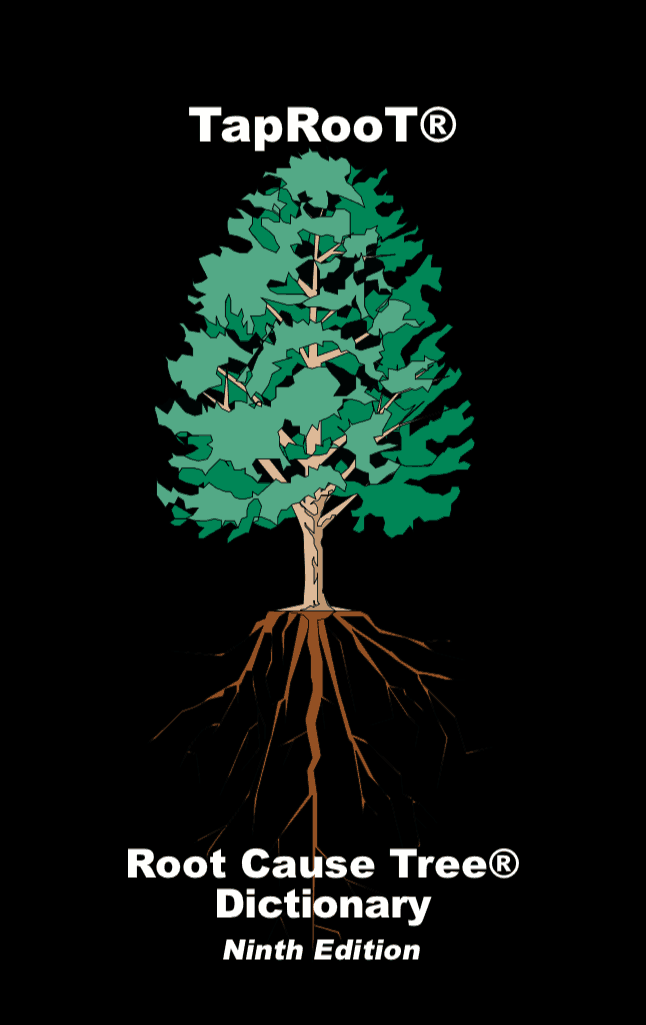Use the TapRooT® Root Cause Tree® Dictionary to Improve Your RCA

The TapRooT® Root Cause Tree® Dictionary
The TapRooT® Root Cause Tree® Dictionary is a detailed set of questions that helps you consistently identify root causes using the evidence you collected and organized on your SnapCharT® Diagram. The TapRooT® Root Cause Tree® Dictionary provides a common root cause analysis language for your investigators and helps the investigators consistently find root causes using their investigation evidence. This makes for consistent root cause analysis identification and the ability to trend the results.
The TapRooT® System
TapRooT® Users have more than a root cause analysis tool. TapRooT® Users use an investigation and root cause analysis system.
The TapRooT® System does more than root cause analysis. It helps you investigate the problem, collect and organize the information about what happened, identify all the Causal Factors, and then find their root causes. Finally, it helps you develop effective fixes.
But even that isn’t all that the TapRooT® System does. It helps companies trend their problem data to spot areas needing improvement and measure performance.
The TapRooT® System’s “secret sauce” is the Root Cause Tree® Diagram coupled with the TapRooT® Root Cause Tree® Dictionary.

These tools are built into the two processes (one for simple incidents and one for major incidents) that guide investigators to a superior investigation result.


Using the TapRooT® Root Cause Tree® Dictionary
For each node on the Root Cause Tree® Diagram, there is a set of questions in the Root Cause Tree® Dictionary that define that node. If you get a “yes” for any of those questions, it indicates that you should continue down that path to see if there is an applicable root cause. At the root cause level, you answer the questions to see if you have the evidence you need to identify a problem that needs fixing (needs improvement).

For example, to determine if the root cause “hot/cold” under the Work Environment Near Root Cause under the Human Engineering Basic Cause Category is a root cause for the Causal Factor that you are investigating, you would answer the questions shown in the TapRooT® Dictionary above:
- Was an issue caused by excessive exposure of personnel to hot or cold environments (for example, heat exhaustion or numbness from the cold)?
- Did hurrying to get out of an excessively hot or cold environment contribute to the issue?
- Did workers have trouble feeling items because gloves were worn to protect them from cold or hot temperatures?
If you get a “Yes,” then you have a problem to solve.
How do you solve it? You use Safeguards Analysis and the Corrective Action Helper® Guide. Attend one of our TapRooT® Root Cause Analysis Courses to learn all the secrets of the advanced TapRooT® Root Cause Analysis System.
The expert systems built into the Root Cause Tree® Diagram and TapRooT® Dictionary expand the number of root causes that investigators look for and help investigators identify root causes that they previously would have overlooked. This helps companies more quickly improve performance by solving human performance issues that previously would NOT have been identified and, therefore, would not have been fixed.
The TapRooT® Root Cause Tree® and Dictionary are also built into the TapRooT® Software. Using the software makes the TapRooT® System even easier to use.

Are You Using a Tool or a System?
Some people think a simple root cause analysis tool is good enough. They don’t dig into the causes of human errors or have advanced troubleshooting methods for equipment failures. They just ask “Why” or get a bunch of smart people in a room and hope that they figure something out. (Maybe brainstorming will help.)
Unfortunately, these unsystematic methods often lead to substandard corrective actions and repeat problems. People think an issue was solved until it happens again.
They should be using a guided root cause analysis process with embedded knowledge to take them beyond their current knowledge.
Where Can You Get a Root Cause Tree® Dictionary?
That’s easy. You get one with any of our TapRooT® Root Cause Analysis Courses or when you order Book 3, Book 4, or the whole book set (that is the dictionary at the right in the picture below)

Order the books at this LINK.
Learn a Systematic Process for Root Cause Analysis
If you need the most advanced root cause analysis system, attend one of our public TapRooT® Root Cause Analysis Courses. CLICK HERE for more information about the course choices. For a complete list of our public courses being held around the world, CLICK HERE. And to sponsor a course at your site, CONTACT US for a quote.

(Note: Copyrighted material shown above is used by permission of System Improvements.)



